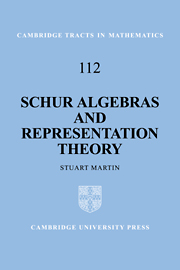Book contents
- Front matter
- Contents
- Introduction
- 1 Polynomial functions and combinatorics
- 2 The Schur algebra
- 3 Representation theory of the Schur algebra
- 4 Schur functors and the symmetric group
- 5 Block theory
- 6 The q-Schur algebra
- 7 Representation theory of Sq(n, r)
- Appendix: a review of algebraic groups
- References
- Index of Notation
- Index of Terms
4 - Schur functors and the symmetric group
Published online by Cambridge University Press: 22 September 2009
- Front matter
- Contents
- Introduction
- 1 Polynomial functions and combinatorics
- 2 The Schur algebra
- 3 Representation theory of the Schur algebra
- 4 Schur functors and the symmetric group
- 5 Block theory
- 6 The q-Schur algebra
- 7 Representation theory of Sq(n, r)
- Appendix: a review of algebraic groups
- References
- Index of Notation
- Index of Terms
Summary
The equivalence of categories established in 2.2.7 provides a strong link between the representation theory of the Schur algebra and the polynomial representations of GLn. However, there is a third player in the game, namely the symmetric group, whose role in this chapter is fundamental.
In Theorem 4.1.1 the symmetric group G = Σr enters our considerations as follows. If r ≤ n there is a functor from PK(n,r) to KGmod induced by sending a polynomial module to the weight space consisting of vectors on which the element d(t) ∈ T of (1.8), acts as left multiplication by t1…tr. This weight space may be viewed as a module for G using 1.5.2(ii). In fact this procedure is a manifestation of a quite general principle; section 4.1 contains a summary of it. To give a flavour of this, suppose we have a K-algebra S and an idempotent e ∈ S; we therefore induce a functor Homs(Se, –) : Smod → eSemod by sending V to eV. In the special case where S = Sr and r ≤ n there exists a particular e inducing an isomorphism eSe ≅ KG. In this incarnation the Horn functor is known as the Schur functor, and it has a myriad uses. For example Green [1980, §6] showed how to construct the representations of G from a knowledge of the representations of Sr(Г).
Information
- Type
- Chapter
- Information
- Schur Algebras and Representation Theory , pp. 89 - 129Publisher: Cambridge University PressPrint publication year: 1994
